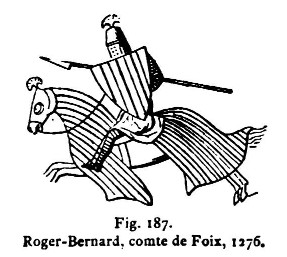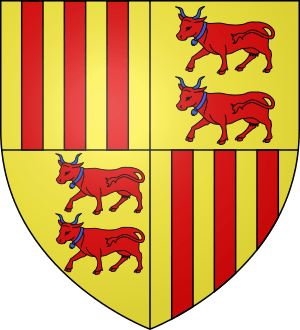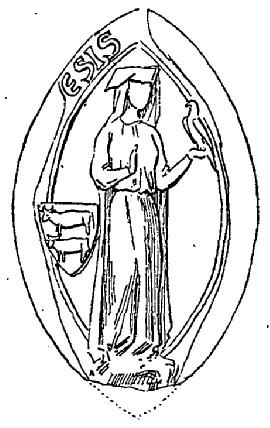Roger-Bernard III, Count of Foix facts for kids
Roger-Bernard III (born 1243 – died 3 March 1302) was an important leader in France. He was the Count of Foix from 1265 until he died. His father was Roger IV of Foix.
Roger-Bernard had conflicts with two powerful kings: Philip III of France and Peter III of Aragon. Both kings even held him captive for a while. Despite these challenges, he was also a talented poet and a troubadour, which was a type of medieval singer and poet.
Contents
Fighting King Philip III
Roger-Bernard's conflict with King Philip III of France started because the French kings wanted more control over the region called Languedoc. This area had been quite independent for a long time.
In 1272, Roger-Bernard teamed up with another count, Gerald VI, Count of Armagnac. They attacked a local lord who then asked King Philip for help. This made the king and Roger-Bernard direct enemies.
The two counts ignored the king's orders and went to war. King Philip, claiming his rights to the land, led a large army into Languedoc. Roger-Bernard fled to his castle in Foix. The king's officer, Eustache de Beaumarchès, took control of Roger-Bernard's lands.
Roger-Bernard then sought protection from James I of Aragon. King James tried to make peace between them. However, Roger-Bernard demanded very strict conditions that were not accepted.
On June 3, King Philip began to attack the castle of Foix. Just two days later, on June 5, the castle fell. Workers called sappers helped by tearing down its strong walls. Roger-Bernard surrendered and was sent to prison in Carcassonne.
The disagreement between King James and King Philip continued for a bit. King James did not want to give up the lands he held for the imprisoned count. But on February 8, 1273, they settled their dispute. The King of Aragon gave up his claims.
Later that year, Roger-Bernard was released from prison. He promised loyalty to the King of France and got some of his lands back. After this, Roger-Bernard and Philip III had a good relationship. In fact, King Philip even called him his "most loyal and faithful vassal" in 1277.
When King Henry I of Navarre died in 1274, there was a disagreement about who should rule the small kingdom of Navarre. Henry's daughter, Joanna, was the rightful heir. She was married to Philip the Fair, who would later become King of France.
However, the Aragonese people did not want a French ruler in Navarre. To help Joanna and Philip get their rightful inheritance, Roger-Bernard led a French army into Navarre in September 1276. He captured the capital city of Pamplona by force and destroyed parts of it.
As a reward for his help, King Philip III gave Roger-Bernard back all his remaining lands south of the Pas de La Barre.
Creating Andorra
One of Roger-Bernard's most lasting achievements was an agreement he made about Andorra. This small mountain territory had a long history of arguments over who should rule it: the bishop of Urgell or the Count of Foix.
On September 8, 1278, after many talks, Roger-Bernard and the bishop signed a special agreement called a paréage. This was a way of sharing power, like a condominium.
This agreement was slightly changed later that same year. But the paréage system still governs Andorra today. The role of the Count of Foix in Andorra is now held by the Presidency of France.
Fighting Aragon
In the spring of 1280, Roger-Bernard's long-standing conflict with King Peter of Aragon turned into an open rebellion. The Count of Foix formed a group with other unhappy Catalan nobles. They revolted against King Peter.
Roger-Bernard was surrounded in Balaguer and had to surrender on July 22. He was then put in prison. While other leaders of the revolt were set free the next year, Roger-Bernard stayed in an Aragonese prison until December 1283.
He was finally released because it was helpful for King Peter to free him. In exchange, Roger-Bernard gave up the viscounty of Castelbon. This was done to try and stop a French invasion, known as the "Aragonese Crusade."
However, Roger-Bernard did not feel loyal to King Peter. He quickly joined the invading French army. First, on May 25, 1285, Elne surrendered to the French. Then, on September 7, Girona also surrendered. Roger-Bernard helped negotiate these surrenders.
Working with King Philip IV
In 1290, Roger-Bernard tried to stop the king's officers from interfering in his lands. These officers were involved in things like justice and collecting taxes. King Philip IV, who was now King of France, refused to stop his officers. He did not want to lose his power in the south.
As a result, King Philip took two of Roger-Bernard's castles as punishment. But in 1293, the king finally ordered his officer to leave Roger-Bernard's matters to him. In 1295, King Philip made Roger-Bernard the Governor of Gascony. On April 29, he ordered the officer to return the castles that were taken in 1290.
In 1295, Roger-Bernard claimed that the king's officer was collecting taxes without his permission. These taxes were meant to pay for a war with England. To make up for these taxes, King Philip gave Roger-Bernard more castles in July 1295 and 1298.
When Bernard Saisset, the bishop of Pamiers, tried to start a revolt in Toulouse, he asked Roger-Bernard to lead it. Roger-Bernard refused and told the king about the bishop's plans.
Inheriting Béarn
In 1252, Roger-Bernard married Margaret of Béarn. She was also known as Margaret of Montcada. Her father, Gaston VII of Béarn, said in his will that Margaret would be his heir. Most people accepted this.
However, Gaston later changed his mind and named his third daughter, Guillemette, as the new heir. But when Gaston died in 1290, Roger-Bernard immediately took control of the lands he believed were his (in May). Roger-Bernard then combined his family's coat of arms with that of Béarn.
In 1293, after three years of peace, Margaret's sister Mathe and her husband Gerard V finally challenged Roger-Bernard's claim to Béarn. This started a long war over their wives' rights, which lasted until 1377.
In April 1300, Guillemette gave all her lands in Catalonia to James II of Aragon. Roger-Bernard did not agree with this. He traveled with his troops through the Col de Puymorens pass in the Pyrenees mountains to stop her.
Roger-Bernard III died at Tarascon-sur-Ariège on March 3, 1302. He was buried in Boulbonne next to his ancestors.
Roger-Bernard and Margaret had several children:
- Gaston I, who became the next Count of Foix.
- Constance, who married John I de Lévis in 1296.
- Mathe, who married Bernard IV of Astarac in 1294.
- Margaret (died 1304), who married Bernard IV Jordan of L'Isle-Jourdain in 1291.
- Brunissende, who married Elias VII of Périgord in 1298.
Sources
| Preceded by Roger IV |
Count of Foix 1265–1302 |
Succeeded by Gaston I & VIII |
| New title | Prince of Andorra 1278–1302 with Pere d'Urtx (1278–1293) Guillem de Montcada (1295–1302) |
|
| Preceded by Gaston VII |
Viscount of Béarn 1290–1302 |
See also
 In Spanish: Roger Bernardo III de Foix para niños
In Spanish: Roger Bernardo III de Foix para niños




